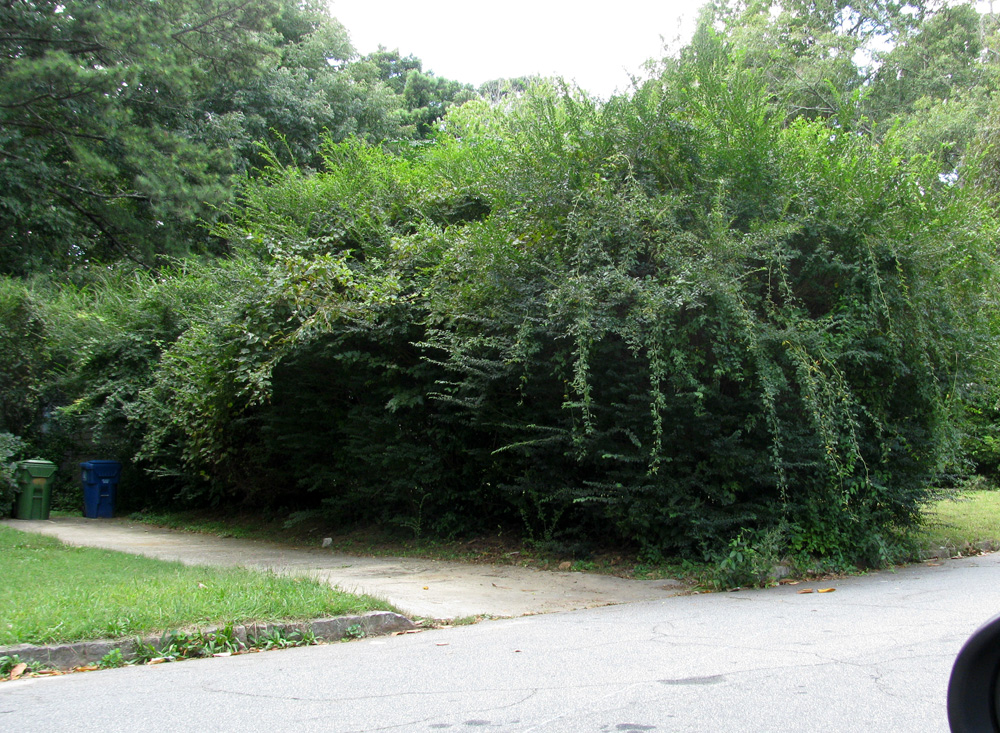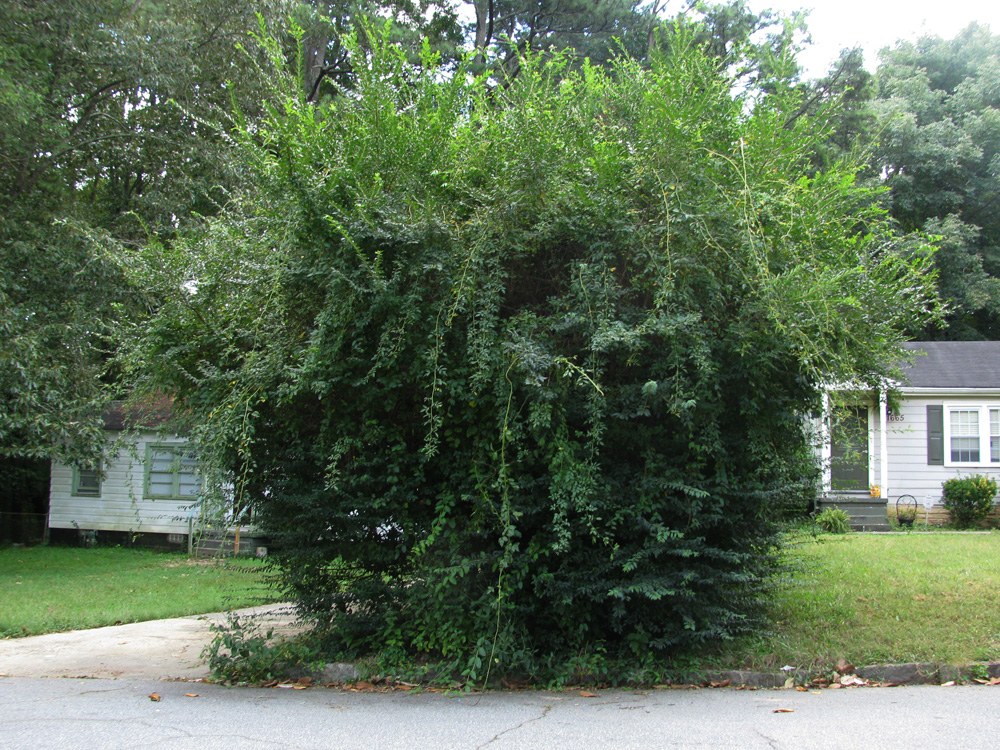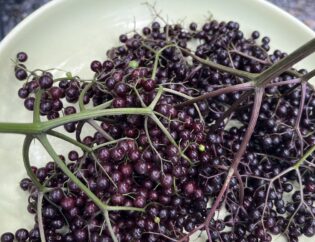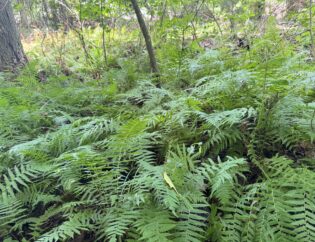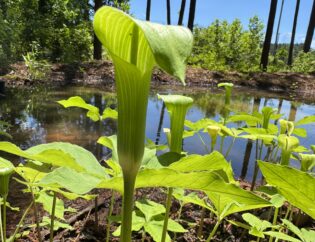
If you are already sighing in disgust and seeing red in your peripheral vision then you have probably dealt with Privet. Those of you that don’t know what Privet looks like aren’t paying enough attention to the plants you pass each day. If you are in the Southeast US, then I guarantee you pass some on any trip that involves crossing a floodplain/drainage/creek/river.
Chinese Privet (Ligustrum sinense), Japanese Privet (Ligustrum japonicum) and European Privet (Ligustrum vulgare) are all woody, multi-stemmed, semi-evergreen deciduous shrubs or small trees. They all look very similar and are all terribly invasive, so I will simply refer to them interchangeably as ‘privet’ from here on out. Privet was introduced to North America in the early to mid-1800s, and continues to be propagated and sold today. It forms dense colonies, retains its olive green leaves nearly year round, and can be evergreen near the coasts. This makes it an “ideal” plant to form hedgerows for privacy, especially since the dense branching allows it to be trimmed in to all manner of shapes and sizes.
This is a perfect example of a healthy Privet hedgerow in need of a trim. Note the trash cans for scale.
This one has a number of other invasive vines coming out of the top, but you get the idea. It makes a good visual screen from those nosy neighbors. The main reason privet makes such dense colonies is because it sprouts new stems from its lateral roots, commonly referred to as “root suckers.” Damaging or severing the roots is thought to (and in my experience definitely does) cause new stems to grow. Add this to the fact that privet is a prolific bloomer and berry producer and you can begin to see how birds and time have aided it in creeping into any semi-moist, partly shady area in the Southeast. Away from the hedge shears and lawnmowers privet forms large, fast-growing colonies and can easily shade out most other plants.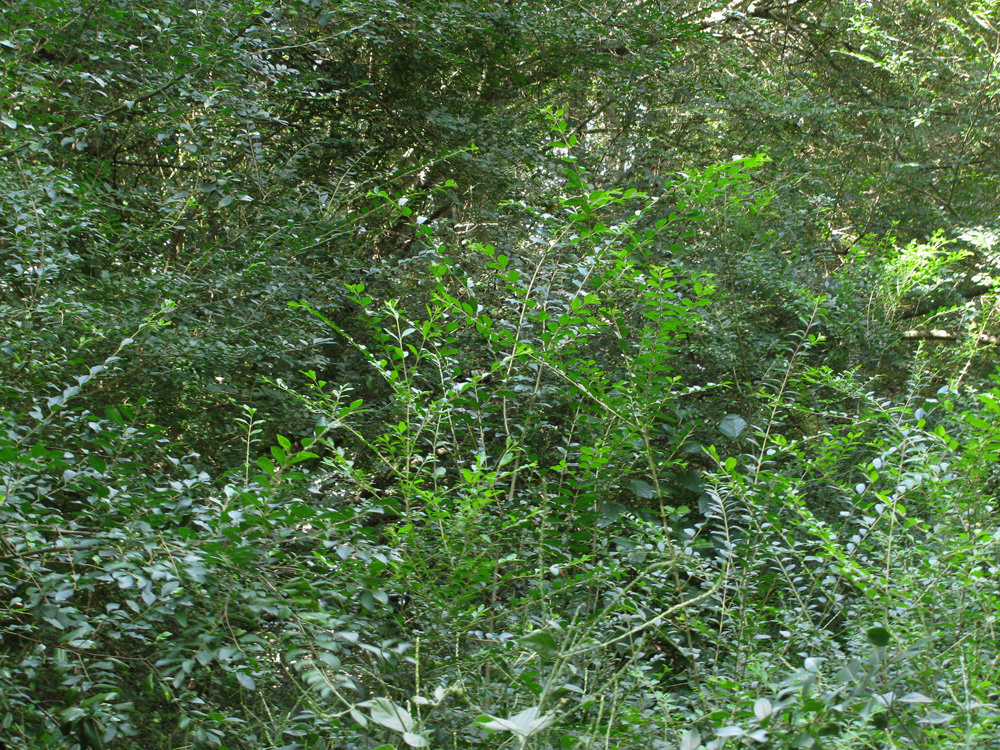
This is terrible news for the native plants, insects, and birds that depend on shady areas as their environmental niche in order to play their roles in the overall ecosystem. The diverse mix of understory plants and shrubs that inhabit the marginal areas of the Piedmont and other Southeastern forests bloom from early February (Trout Lilies, Trilliums) to Late November (Giant Sage and multiple Aster species) and are constantly making leafy new growth that hosts the caterpillars of pretty much every native butterfly and moth species. Privet blooms almost all at once in late Spring and chemical compounds in the leaves make it toxic to most leaf eating insects. Privet does make berries that some birds do eat, but in comparison to the millions of caterpillars (bird food) that would be munching away on the leaves of the native plants privet replaces, the nutritional value is severely lacking.
Removal and Restoration
Now that we have an idea of the costs of privet invasion, what can we do to about it?
1.) Obviously, don’t plant privet. That seems like a no-brainer, but as I mentioned before it is still sold by nurseries as a “hardy, fast-growing hedgerow plant.” The first search hit I got claimed it was the “largest selling hedge plant in North America!” So, I guess I have to say: Do Not Plant Privet. Tell anyone that mentions planting it that it’s a terrible idea.
2.) Remove Privet from any land that is under your care. I consider it a civic duty. Much like Kudzu or English Ivy, it will eventually spread across any property lines that we like to think parcel up the land into distinct units. Privet actually thrives as the manifestation of these imaginary lines in the form of hedges. It might not be feasible to take down a hedge like the one pictured above all at once, especially if it is straddling the fence line. Any unwanted colonies wholly on your property can be slowly and deliberately removed with the right tools and perseverance.
The good news is that almost all Privet seeds germinate the first year that they are in the ground. It’s good news because there is no residual seed bank that builds in the soil, so if you can remove all of the plants/roots they should stay gone. It also means you have to stay on top of your weeding to keep those tiny seedlings from becoming established shrubs. The top tool in the picture is your best ally against any privet with a stem smaller than a No. 2 pencil. The two prongs can be used to grab and pry up the roots so that the whole plant is removed. The roots are extensive and will break (causing new stems to sprout from the fragments) so its best to pull them after a rain, or wet down the soil first.
Loppers and saws can be used in several ways to slow or prevent the spread of larger more established privet:
1.) Cut off the flowers/berries before they are able to fully develop viable seeds. If you can’t fully remove the plants you have, you can at least prevent them from spreading more than a few feet by removing their highly transportable seeds. The seeds ripen in Late September/October, so right now is the time to do this! It might take an hour or two but it’s much easier on your back than pulling seedlings.
2.) Cut down the entire tree/shrub. This will cause the roots to resprout, which I will discuss below, but taking out the privet canopy will allow other plants a chance to compete for sunlight and start to recolonize the area. A three foot tall pencil sized privet stalk is better than multiple fifteen foot tall fence-post size stalks. It’s not oak, but it makes decent firewood. There’s always hugelkultur as well, as long as you completely dry it out first!
Root Eradication
For any privet plants with a stem larger than a pencil the roots are going to require more than a tiny hand tool. My favorite tool for the mechanical removal of large privet roots is called a Weed WrenchTM. It’s basically a giant clamp on a lever that gives you the mechanical advantage to tear the wide, shallow root systems out by the base of the stem. It’s a fairly expensive, large tool that has basically one purpose, so borrowing or renting one is probably the best option for most people.
The other option is to use chemical controls in the form of systemic herbicides. This is the least preferable option in my book, but if used in a careful and responsible manner chemical controls can kill privet roots with little or no collateral damage to other plants. The herbicide glyphosate is sold under several brand names and is available at most hardware/garden supply stores. In addition to the herbicide and your lopper/saw you will need one more tool for this method: a grout sealer brush/bottle.
You should be able to find an empty one for sale in the tile section of that same hardware store. There’s a small hole in the middle of that brush on the tip to allow the liquid in the bottle to ooze out onto the brush.
So, once you have these tools assembled:
- Mix your glyphosate to the recommended dilution (if it isn’t pre-mixed). I once bought the syrup-like concentrate and figured “The stronger the better” and applied that directly onto a cut stump, but this actually makes it harder for the plant to transport the herbicide throughout the root system. Follow the label for the proper proportions.
- Carefully pour the glyphosate mixture into the grout sealer bottle and affix the brush cap.
- Cut all privet stems to be treated down to near ground level.
- As soon as possible come back by and carefully apply the herbicide by brushing it onto the cut stem surface. Several passes of the brush while waiting for the plant to absorb the liquid in between assures maximum damage. Two people, one cutting, one brushing, make this go much faster.
- Continue to cut and brush resprouts as they emerge.
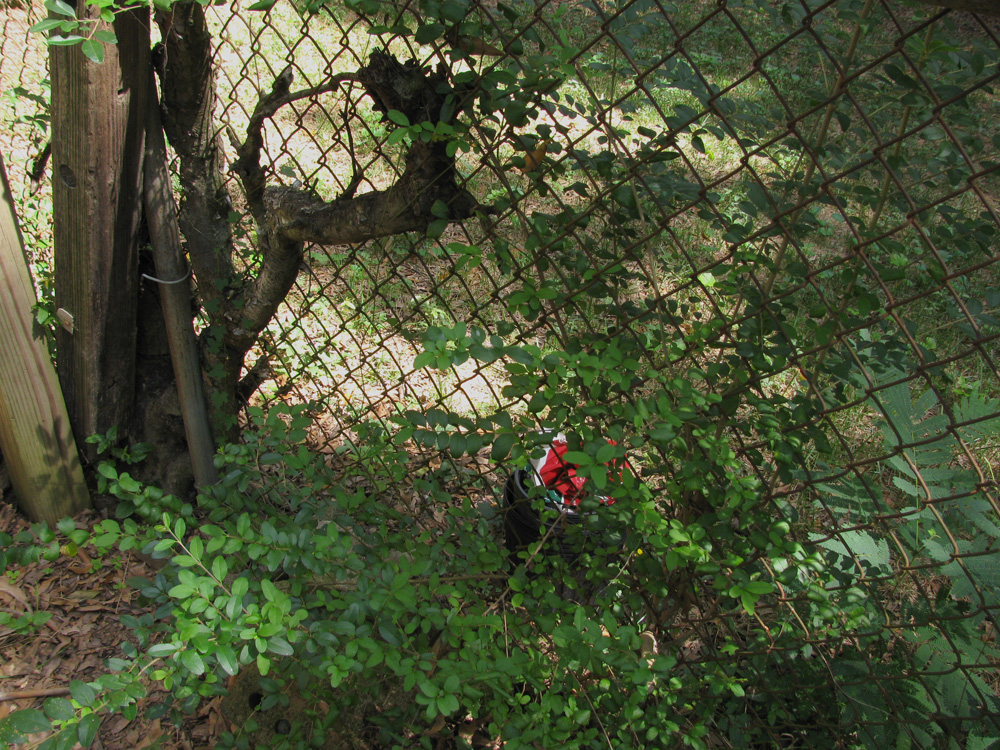 This is on the fence line in my backyard. The large “old growth” privet stem on the left had grown completely through and engulfed the fence. There was no way to remove it physically without destroying the fence, so I used the cut and brush method. Before I cut the trunk it was a full grown, 25 foot tall tree-sized plant that cast a wide, deep shadow. Now, as you can see in the foreground, the roots continue to resprout, but they are small little things that will be easy enough to lop and brush this fall as I slowly kill more sections of the root system. The initial cut and swab of the large stem killed the root about 2 feet out in all directions. As I said above, just keep at it and the plant will eventually succumb. Right now (Fall) is the best time to do this as well while the plant is pulling energy down to its roots for winter storage.
This is on the fence line in my backyard. The large “old growth” privet stem on the left had grown completely through and engulfed the fence. There was no way to remove it physically without destroying the fence, so I used the cut and brush method. Before I cut the trunk it was a full grown, 25 foot tall tree-sized plant that cast a wide, deep shadow. Now, as you can see in the foreground, the roots continue to resprout, but they are small little things that will be easy enough to lop and brush this fall as I slowly kill more sections of the root system. The initial cut and swab of the large stem killed the root about 2 feet out in all directions. As I said above, just keep at it and the plant will eventually succumb. Right now (Fall) is the best time to do this as well while the plant is pulling energy down to its roots for winter storage.
The added benefit of direct, brush applications as opposed to spraying the herbicide is that you never know what native plants are hiding under the ground just waiting to pop back up once that dense shade is removed. The herbicide-grout-brush method was taught to me by Ed and Sue of the Memorial Park Weed Warriors in Athens. With the help of many volunteers they removed large quantities of privet from the park using this method a few years back. Their care and diligence were rewarded the following spring with a hillside full of gorgeous Bloodroot (Sanguinaria canadensis) blooms. Follow the above link to their Facebook page to see the gorgeous photos! Had the entire area been soaked down with a sprayer full of herbicide the Bloodroot would have stood little chance of surviving. I have peppers growing about 2 feet away from my fence line pictured above, and if I accidentally killed them with a cloud of herbicide that drifted over from the privet I would be sad and my homemade pepper jelly would suffer. Caution and careful use of herbicides when they are needed will help you keep the plants you want and remove the ones you don’t.
Restoration
Once you have the privet knocked out there are plenty of native shrubs that will thrive in the same area. Beautyberry (Callicarpa americana), Spicebush (Lindera bezoin), and Sweetshrub (Calycanthus floridus) are just a few. Replacing the privet with native shrubs is the final rewarding step in this long process. You and all of the non-human residents of your yard will be much better off in the end.
